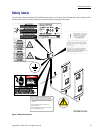
Training your staff
What to do when the alarm sounds
The following steps are suggested procedures only. We recommend that all staff develop a complete understanding of the
library’s policies and follow them as directed. The response should be consistent for all patrons caught in an alarm. It is also
important that staff become familiar with state and local laws governing patrons’ rights and responsibilities.
3M offers these guidelines:
Responding to alarms is a sensitive situation but can be handled confidently and effectively as long as your library has
established procedures and your staff members are fully trained in following them.
First, don’t panic. Remain calm and courteous. You can’t be positive that the person who triggered the alarm is stealing. Never
accuse anyone of theft by word, by facial expression, or by tone of voice. The alarm may have been triggered accidentally,
so always respond in a positive, non-threatening manner.
Alarm Scenario 1
The library staff does not desensitize a tagged item when checking out the patron’s materials, or the patron accidentally
removes marked materials from the library.
After asking the patron to return to the counter, a typical response might be, "Excuse me, did I forget to check out one of your
items?" or "Did you perhaps pick up one of the library’s books with your own things?” These are courteous questions, and
they don’t accuse the patron of theft. Be sure to smile and ask the questions in a friendly, non-threatening manner.
Process and desensitize all items again. If you discover an item that hasn’t been properly checked out, never accuse the patron
of stealing. Simply act as if the error was an oversight—it more than likely was. If the patron causes the alarm to sound again,
follow the policy that your library has established for possible theft of materials.
Alarm Scenario 2
A patron denies having any library materials or runs out of the library after sounding the alarm.
Follow your library’s policy for theft.
Unwanted alarms
Your detection system is virtually free of false alarms. Occasionally your system may alarm and your staff may find that the
patron does not have unauthorized library materials. Unwanted alarms may be caused by active strips on items carried into
the library such as books from another library.
Unwanted alarms are generally infrequent and will vary depending on the patrons and the proximity of your library to facilities
that are releasing items containing security strips. Because it is not possible to distinguish between unwanted alarms and
alarms with potential item loss, all responses to alarms must be consistent and follow your management policies. If patrons see
no response to alarms, the system becomes less effective. When you decide that a security strip on an item from outside your
library caused an alarm, follow these steps:
1. Explain the problem to the patron.
2. Verify that all of the patron’s library materials are properly checked out.
3. Allow the patron to exit the library.
Many patrons will learn from the experience and will not carry items that may cause alarms into the library.
Alarm log
The alarm log is used to keep a record of details involving alarms that occur. See Detection system alarm log on page 21. For
each alarm, record the information on the log. Keeping this log up-to-date provides a key tool for monitoring system activity.
An up-to-date alarm log provides useful information for library management and your 3M service representative.
4
Copyright © 2008. 3M. All rights reserved.


















